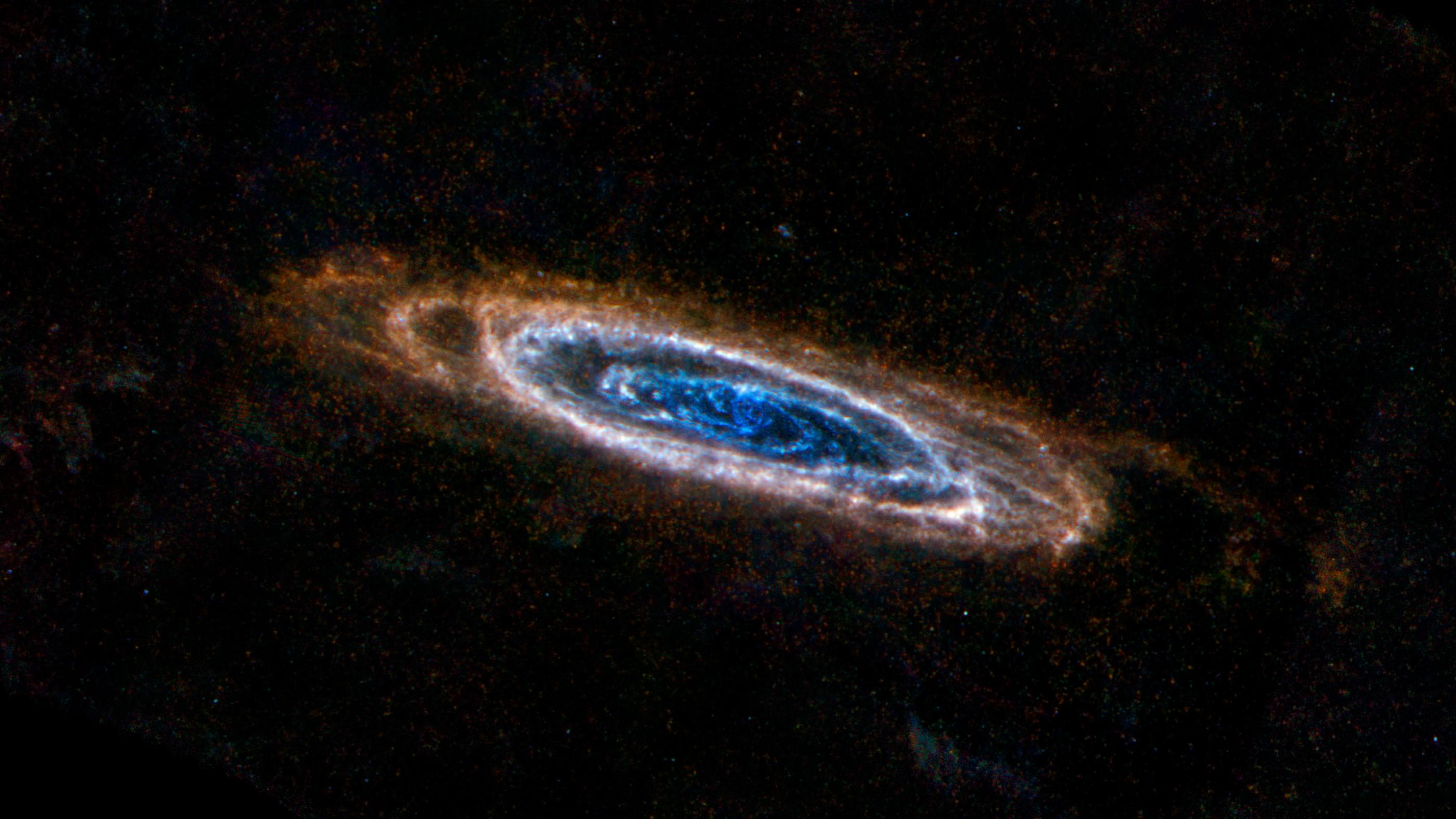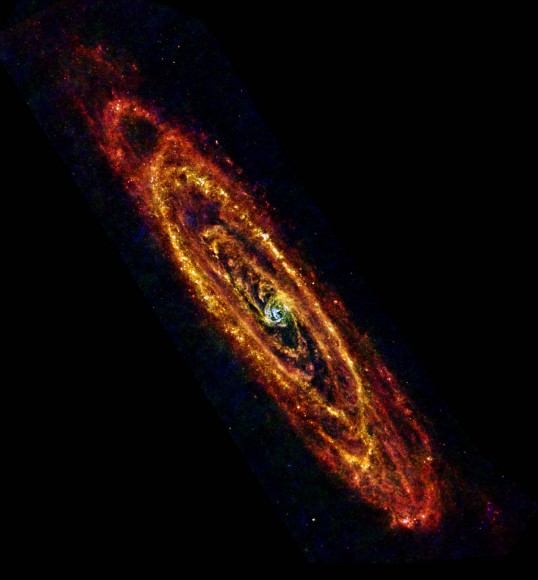Cold rings of dust are illuminated in this image taken by Herschel’s Spectral and Photometric Imaging Receiver (SPIRE) instrument. Credit: ESA/NASA/JPL-Caltech/B. Schulz (NHSC)
Looking wispy and delicate from 2.5 million light-years away, cold rings of dust are seen swirling around the Andromeda galaxy in this new image from the Herschel Space Observatory, giving us yet another fascinating view of our galaxy’s largest neighbor.
The colors in the image correspond to increasingly warmer temperatures and concentrations of dust — blue rings are warmer, while pinks and reds are colder lanes of dust only slightly above absolute zero. Dark at shorter wavelengths, these dust rings are revealed by Herschel’s amazing sensitivity to the coldest regions of the Universe.
The image above shows data only from Herschel’s SPIRE (Spectral and Photometric Imaging Receiver) instrument; below is a mosaic made from SPIRE as well as the Photodetecting Array Camera and Spectrometer (PACS) instrument:
“Cool Andromeda” Credit: ESA/Herschel/PACS & SPIRE Consortium, O. Krause, HSC, H. Linz
Estimated to be 200,000 light-years across — almost double the width of the Milky Way — Andromeda (M31) is home to nearly a trillion stars, compared to the 200–400 billion that are in our galaxy. And within these cold, dark rings of dust even more stars are being born… Andromeda’s star-making days are far from over.
Read more: Star Birth and Death in the Andromeda Galaxy
Herschel’s mission will soon be coming to an end as the telescope runs out of the liquid helium coolant required to keep its temperatures low enough to detect such distant heat signatures. This is expected to occur sometime in February or March.
Herschel is a European Space Agency cornerstone mission with science instruments provided by consortia of European institutes, and with important participation by NASA. Launched May 14, 2009, the telescope orbits the second Lagrange point of the Earth-Sun system (L2), located 1.5 million km (932,000 miles) from Earth. Read more from the Herschel mission here.



What a sad day it will be when it runs out of coolant. Just amazing images.
The Andromeda galaxy may be on a collision course, but I’ll bet it’s gonna swerve first.
And how much would it be worth to the ESA to have someone go there and refill the dewars? Elan?
I copied the source of that second image.. took it into Picture Manager and zoomed in on the core. Taka look at that maelstrom… what do you see? I see a ‘top’ or spindle shape ejecting matter like a garden sprinkler! The orientation of that ‘sprinkler’ now seems to be rotating perpendicular to the plane of the galaxy? As though the top of the spindle shaped object would be the polar axis jet of a super-massive black hole rotating on it’s side? like a spun (spinning) down gyro? or is that spun up? Ejection rates might provide de-spin wobble?
I thought the nucleus of Andromeda pictured by Herschel looked like some of the images of the center of our own galaxy: http://blackholes.stardate.org/directory/image.php?o=milky-way-sagittarius-a&p=gc_hst_8mu
Yes.. in comparing these two images… I find it interesting that our galaxy’s ‘water sprinkler’s jet orientation(s) also appears to be rotating nearly perpendicular to the orientation of the spiral arms? But our galaxy seems to have THREE garden sprinkler jets? Or is it that the forth jet is hidden beyond? implies merging black holes?
The odd perpendicular jet(s) might be a collision artifact due to the angle of orbital insertion and subsequent rotational processing?
As galactic cores collide and coalesce they determine the eventual structure. An elliptical galaxy may be the result of several similar mass ‘garden sprinklers’ merging? The ejected energy and mass processing radially from several jets and evolving into a spherical object?
Root
of 3/2 x Pi x Avogadro Number (treated all values in cm) = 2.3147 x10^24 cm. where,
2.5 million light years = 2.565 x10^24 cm. Again 200000 light years = 1.8921 x
10^23 cm. But the distance of Andromeda galaxy is 1.892 x10^24 cm = Pi x
Avogadro Number (in cm) = 1.8919 x 10^24cm. and it is 10 times larger distance
than 1.8921×10^23 cm. “And within these cold, dark rings of dust even
more stars are being born… Andromeda’s star-making days are far from over”.
Yes, dust rings means populated black particles,
black particles are responsible to create huge amount of photon particles, altogether
forming stars. I calculated that 10^24 black particles forms a photon. The mass
of a photon is 1.659×10^-54 gm (written in my book, Complete Unified Theory
(page-424, 1998) or in Mystery of Origin of the Universe (page-193, 1990). The stars,
planets taking its own position accordingly as per its choice of distance which
will depend on the new unit as 2 x Pi^2 x Avogadro Number x R (ratio of Atom
& Electron) = 2.166 x10^28 cm (radius of the Universe, written in the book Complete
Unified Theory (page-215). This radius is related to all galaxies, stars,
planets etc. The universe is creating & playing in this region.
Nirmalendu Das
Dated: 31-01-2013.